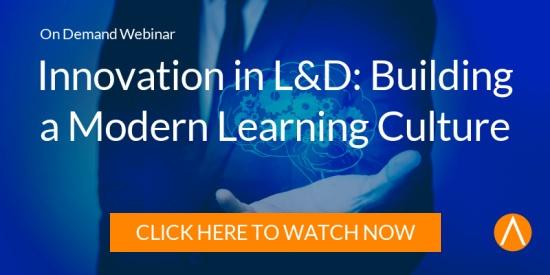Posted by Caveo Learning ● April 27, 2017
Building Business Credibility and Impact Beyond the L&D Bubble
 Learning professionals tend to surround themselves with others who speak the same language of L&D and face similar industry challenges. That’s fine and understandable, but regardless of one’s expertise and preparation, the result is that business stakeholders may fail to understand and appreciate the value of L&D and the challenges facing learning leaders.
Learning professionals tend to surround themselves with others who speak the same language of L&D and face similar industry challenges. That’s fine and understandable, but regardless of one’s expertise and preparation, the result is that business stakeholders may fail to understand and appreciate the value of L&D and the challenges facing learning leaders.
This is frustrating, but not surprising. L&D professionals spend so much time with one another that it can be easy to forget or neglect to prioritize building strong relationships with leaders in other areas of the business.
The good news is, each day offers opportunities to go beyond the L&D bubble and really get inside the business, start the conversation, and gain credibility for your L&D organization. Here are some tips for learning leaders to build business credibility and relationships with counterparts across the enterprise.
Lay the Groundwork
Take stock in what you already know about the business lines that your L&D team supports. Identify the business leaders you most want to get to know, and ask your team for inputs to understand who the primary influencers are within the business. Then spend some time researching business unit challenges and market pressures; effective communication starts with having a deep understanding of the business itself. Take note of business jargon other leaders use in meetings, and pay particular attention to the comments and questions they ask you directly.
Make efforts to be more prominent in meetings you already attend by asking follow-up questions, volunteering for cross-functional projects, and offering to consult on performance issues that arise. Efforts to expand L&D’s visibility and influence will help establish the foundation for taking the next step.
Start the Conversation
Reach out to the key stakeholders you identified previously and schedule casual one-on-one meetings with each. Grab coffee or go to lunch. Start by chatting up folks who have shown support for the learning function in the past—it’s helpful to have allies before attempting to gain new converts.
 As with any successful networking effort, these conversations must be genuinely focused on the other person and their needs, not yours. Set the tone by communicating your sincere interest in their work. Reassert L&D’s commitment to supporting them in their success. Be candid about the limitations of your knowledge—but be clear about your desire to learn—and set the expectation that you want honest, open conversation. And then ask questions!
As with any successful networking effort, these conversations must be genuinely focused on the other person and their needs, not yours. Set the tone by communicating your sincere interest in their work. Reassert L&D’s commitment to supporting them in their success. Be candid about the limitations of your knowledge—but be clear about your desire to learn—and set the expectation that you want honest, open conversation. And then ask questions!
- What’s most interesting about your line of business? Your customers?
- What’s going well?
- What are the biggest challenges right now?
- What challenges or shifts do you foresee?
- What are your strategic goals for the year? The quarter?
- Are there specific barriers to be overcome?
- What metrics and KPIs can be used to measure effectiveness, efficiency, and outcomes?
- How much impact has L&D had?
- When there are performance issues, who do they reach out to? If not L&D, why not?
- How can L&D provide better support in the future?
- Are there meetings that would be valuable for you to attend to keep in closer contact to the emerging needs of the business? (Sometimes this question will be met with reluctance. If this happens, offering to dial in as a silent auditor may be a first step toward true inclusion. Depending on past history and assumptions, baby steps may actually be huge leaps forward!)
Drive to Add Value
Stay attuned to comments that indicate performance gaps and follow up with focused performance-consulting conversations. Be proactive yet gentle. Really listen to concerns and empathize with pain points before diving into conversations about identifying root causes and any potential solutions, lest your good intentions fall flat. Take time to acknowledge when things seem to be going well, and seek understanding of what “the next level” might look like and how to get there. Being a partner through the ups and the downs, recognizing gains in traction, is important for the long-term strength of the relationship.
As you gain business-specific knowledge, share it with your team to help them better understand the language of the business, what questions to ask SMEs, etc. Leverage appropriate roles to lead performance consulting conversations to truly understand the root cause of business leaders’ pain points. Build the business acumen within your team and coach them on how to use it when speaking with business leaders, SMEs, and learners. Elevating your team’s skill gives you more touchpoints for making a positive impression inside the business.
Gain Alignment, Build Credibility, Create Impact
Follow up with your business counterparts on a regular basis, ensuring that any changes in strategic direction are understood and can cascade into L&D priorities. Moreover, don’t be afraid to discuss life beyond work; personal connections can bind us in our work relationships.
As you build these relationships, leverage them to build more. Seek introductions to other influencers throughout the organization. Ask more questions in cross-functional meetings. Highlight the support that your L&D team can offer each business unit, based on your evolving understanding of their needs and challenges. Be specific on the consulting and solutions that L&D can provide, its potential value, and the process.
Take regular opportunities to present during meetings, echoing concerns you have heard within the business and connecting them to L&D initiatives. Then, describe how these initiatives can impact metrics and KPIs important to the business. Avoid using typical L&D jargon and L&D-specific metrics. Speaking the language of the business will help you connect the dots between their pain points and how you can partner to create impactful solutions.
It takes focused effort for us as learning leaders to step into the business and build credibility with our business peers, but it is a worthwhile investment of time and energy to become the trusted advisor and partner that adds visible value. With alignment to business needs, the impact of your L&D strategy on the organization will earn your team credibility and a permanent seat in strategic business conversations.
As a learning strategist with Caveo Learning, Ashley Christian works with learning leaders to deliver tangible business value through strategic learning consulting and implementation of learning and performance solutions and technologies. Before joining Caveo’s strategy team, she was a senior instructional designer for high-profile clients in the technology, energy, and financial services fields. Ashley holds a degree in leadership and development from Texas A&M University and is an active member of the Austin Chapter of ATD.
Topics: Managed Services, Learning Strategy

